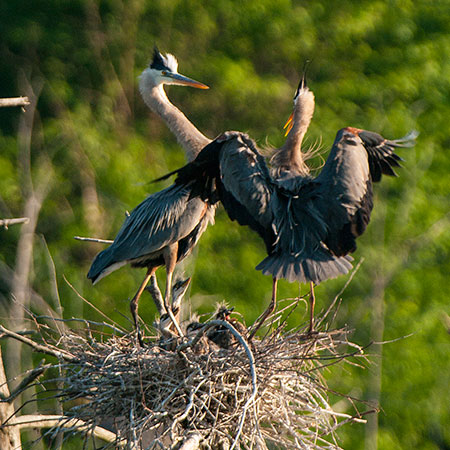The birds and the apes

Great blue heron nest, with four chicks all wanting food, near Grass Lake. Photo of the Day archive: Vici and Steve Diehl, Antwerp, NY
I had a good time over the last few days compiling the photo feature titled The North Country Bird Book, which showcases the amazing variety of avian life in the North Country and the best our talented pool of Photo of the Day photographers can offer.
One thing that struck me as I was putting it together was how “bird-poor” the North Country was when I was growing up in the late ’50s and the ’60s. St. Lawrence County was much more intensively farmed in those days and many farmers and municipalities, even the conservation department, had been spraying DDT for decades on the land and water. It turns out the pesticide had a strong hormonal impact on birds, weakening the shells of their eggs. As a result, many species – particularly larger, heavier species – became nearly extinct locally.
I guess everything wasn’t better “back in the day.” I don’t recall ever seeing a heron until the 1970s, after DDT was banned, or an eagle, or a great gray owl. They were just pictures in a bird book. And now they have returned to something like their pre-DDT populations.
And loons were almost wiped out by the same human forces that weakened forests and killed many Adirondack lakes. Acid deposition from burning coal was the culprit in lake die-offs. It is the accompanying mercury content of coal ash that threatens the common loon population. But now loons are recovering, thanks to dedicated conservation efforts, emission controls and the decline of coal as the primary source of electric power.
Dr. Curt Stager says the Adirondack lakes that are recovering from acid rain are not the same. The new ecosystem has an altered food chain from the original. Just as the second growth forest that succeeded the complete felling of the first-growth forests is not the same. Something is regained, but still something is lost.
But these gains do speak against popular cynics who say there is nothing that can be done to confront the environmental challenges we face today. Human activity is powerful for ill, but can also be powerful for good. It is the latter, and the great blue heron that flew over my car on the way home yesterday, that gives me hope – not for a return to the past, but at least for a way forward.







